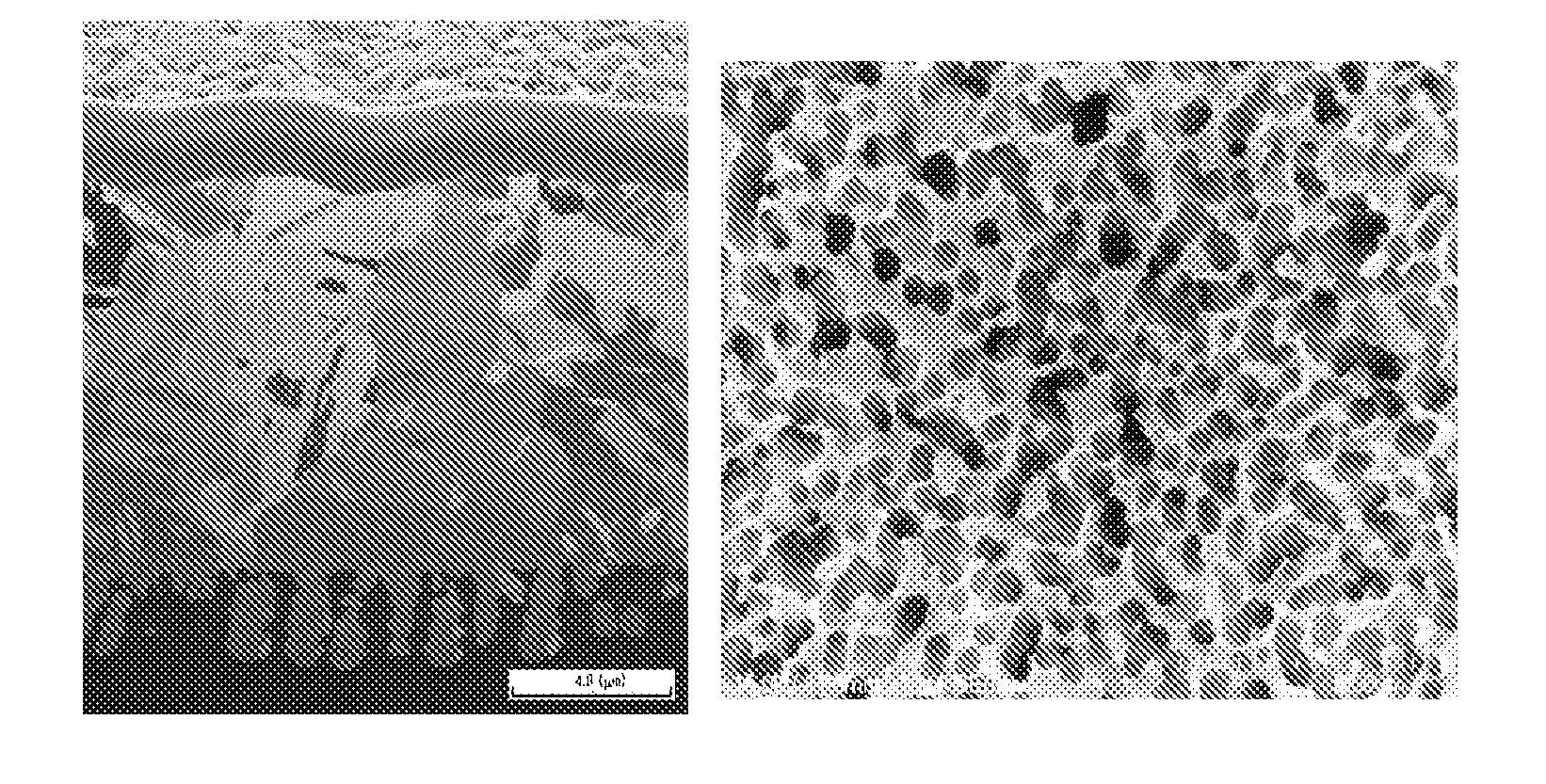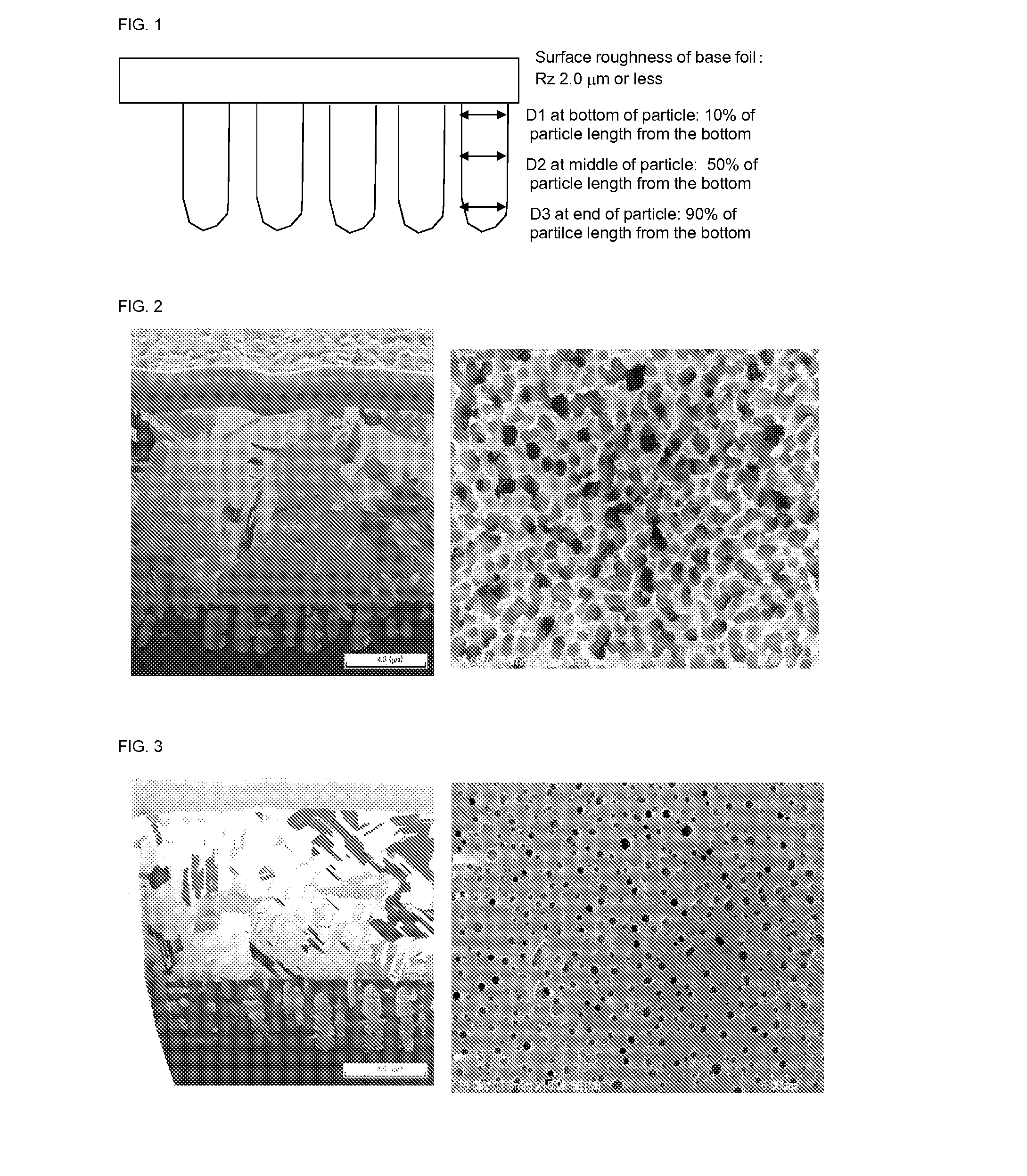Copper Foil with Carrier, Method of Producing Same, Copper Foil with Carrier for Printed Wiring Board, and Printed Wiring Board
a technology of copper foil and carrier, which is applied in the manufacture of circuit precursors, electrolytic inorganic material coatings, and metal pattern materials. it can solve the problems of low mechanical strength of thin copper foil, failure of insulation between circuit patterns, and tear or wrinkles during the production of printed circuit boards. achieve excellent effect, increase the adhesion strength with resin, and high peel strength
- Summary
- Abstract
- Description
- Claims
- Application Information
AI Technical Summary
Benefits of technology
Problems solved by technology
Method used
Image
Examples
example 1
[0196]The rough surface (mat surface: M surface) of a copper foil with a carrier (thickness of ultra-thin copper layer: 5 μm, roughness Rz of roughness-forming surface of ultra-thin copper layer: 0.6 μm) treated as described above was subjected to roughening plating as follows. The treatment conditions are shown below. These are all steps for forming the roughened layer in the copper foil of the present invention. The ratio of current density to limiting current density during roughening particle formation was adjusted to 2.50.
[0197](Liquid Composition 1)[0198]Cu: 15 g / L[0199]H2SO4: 100 g / L[0200]W: 3 mg / L[0201]Sodium dodecyl sulfate amount: 10 ppm
[0202](Electroplating temperature 1): 50° C.
[0203]After the roughening treatment, normal plating shown below was performed. The treatment conditions were as follows.
[0204](Liquid Composition 2)[0205]Cu: 40 g / L[0206]H2SO4: 100 g / L
[0207](Electroplating temperature 1): 40° C.
[0208](Electric Current Condition 1)[0209]Current density: 30 A / dm2 [...
example 2
[0231]The rough surface (mat surface: M surface) of a copper foil with a carrier (thickness of ultra-thin copper layer: 5 μm, roughness Rz of roughness-forming surface of ultra-thin copper layer: 0.6 μm) treated as described above was subjected to roughening plating as follows and to normal plating as in Example 1. The treatment conditions for the roughening plating are shown below. These are all steps for forming the roughened layer of the copper foil of the present invention. The ratio of current density to limiting current density during roughening particle formation was adjusted to 3.10.
[0232](Liquid Composition 1)[0233]Cu: 15 g / L[0234]H2SO4: 100 g / L[0235]W: 3 mg / L[0236]Sodium dodecyl sulfate amount: 10 ppm
[0237](Electroplating temperature 1): 50° C.
[0238]In this roughened layer, the surface roughness Rz was 1.51 μm, the average diameter D1 at the particle bottom being apart from the bottom of each particle by 10% of the particle length was 0.51 μm, the particle length L1 was 2....
example 3
[0244]The rough surface (mat surface: M surface) of a copper foil with a carrier (thickness of ultra-thin copper layer: 5 μm, roughness Rz of roughness-forming surface of ultra-thin copper layer: 0.6 μm) treated as described above was subjected to roughening plating as follows and to normal plating as in Example 1. The treatment conditions for the roughening plating are shown below. These are all steps for forming the roughened layer of the copper foil of the present invention. The ratio of current density to limiting current density during roughening particle formation was adjusted to 4.30.
[0245](Liquid Composition 1)[0246]Cu: 15 g / L[0247]H2SO4: 100 g / L[0248]W: 3 mg / L[0249]Sodium dodecyl sulfate amount: 10 ppm
[0250](Electroplating temperature 1): 50° C.
[0251]In this roughened layer, the surface roughness Rz was 1.56 μm, the average diameter D1 at the particle bottom being apart from the bottom of each particle by 10% of the particle length was 0.59 μm, the particle length L1 was 2....
PUM
| Property | Measurement | Unit |
|---|---|---|
| length L1 | aaaaa | aaaaa |
| diameter D2 | aaaaa | aaaaa |
| diameter D3 | aaaaa | aaaaa |
Abstract
Description
Claims
Application Information
 Login to View More
Login to View More - R&D
- Intellectual Property
- Life Sciences
- Materials
- Tech Scout
- Unparalleled Data Quality
- Higher Quality Content
- 60% Fewer Hallucinations
Browse by: Latest US Patents, China's latest patents, Technical Efficacy Thesaurus, Application Domain, Technology Topic, Popular Technical Reports.
© 2025 PatSnap. All rights reserved.Legal|Privacy policy|Modern Slavery Act Transparency Statement|Sitemap|About US| Contact US: help@patsnap.com


